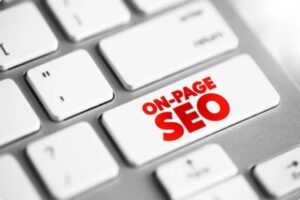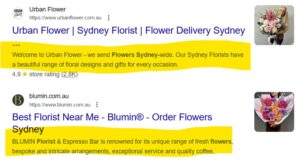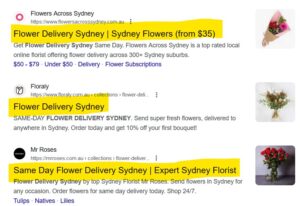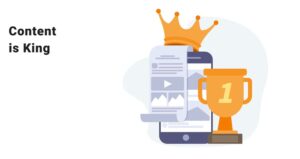Home » On Page SEO
On-Page SEO: The Key to Optimising Your Website for Success
 On-page SEO refers to the practices and techniques used to optimise individual web pages to improve their search engine rankings and drive organic traffic. It encompasses various elements, including content quality, keyword optimisation, meta tags, and user experience. SEM Rush article on on-page SEO is a particularly helfpul resource on this topic.
On-page SEO refers to the practices and techniques used to optimise individual web pages to improve their search engine rankings and drive organic traffic. It encompasses various elements, including content quality, keyword optimisation, meta tags, and user experience. SEM Rush article on on-page SEO is a particularly helfpul resource on this topic.
A solid on-page SEO strategy is essential for any website aiming to enhance visibility and attract more visitors. Here’s a comprehensive overview of on-page SEO and how to implement it effectively.
1. Content Quality
The foundation of effective on-page SEO is high-quality content. Search engines like Google prioritise content that is informative, relevant, and valuable to users. To optimise your content:
- Research and Use Keywords: Identify relevant keywords your target audience is searching for and incorporate them naturally into your content. Focus on both short-tail and long-tail keywords for better results.
- Create Engaging and Informative Content: Ensure your content addresses the needs and interests of your audience. Use clear language, and provide useful information that encourages readers to engage with your site.
- Update Regularly: Fresh content is crucial for ranking well. Regularly update your existing content and add new posts to keep your site relevant.
2. Title Tags and Meta Descriptions
Title tags and meta descriptions are essential on-page elements that influence both SEO and user click-through rates. To optimise these elements:
- Title Tags: Keep them concise (50-60 characters), include primary keywords, and make them compelling to encourage clicks.
- Meta Descriptions: Write clear and concise descriptions (150-160 characters) that summarise the content of the page. Include relevant keywords and a call to action to entice users to click.
3. Header Tags
Header tags (H1, H2, H3, etc.) help structure your content and make it easier for both users and search engines to understand the hierarchy of information. Optimisation tips include:
- Use One H1 Tag: The H1 tag should be reserved for the main title of the page and include the primary keyword.
- Utilise H2 and H3 Tags: Use H2 tags for main sections and H3 tags for subsections. This not only improves readability but also helps search engines index your content effectively.
4. URL Structure
A clean and descriptive URL structure is vital for both users and search engines. To optimise your URLs:
- Keep It Simple: Use short, descriptive URLs that clearly convey the content of the page. Avoid unnecessary parameters and numbers.
- Include Keywords: Incorporate relevant keywords into the URL for better SEO results.
5. Internal Linking
Internal linking helps search engines understand the structure of your website and the relationship between different pages. To enhance your internal linking strategy:
- Link Relevant Content: Connect related articles and pages within your site to encourage users to explore more of your content.
- Use Descriptive Anchor Text: Instead of generic phrases like “click here,” use descriptive anchor text that indicates the content users will find on the linked page.
6. Image Optimisation
Images are a crucial part of your content but can slow down your website if not optimised correctly. To optimise images:
- Use Descriptive Filenames: Name image files descriptively, using relevant keywords where appropriate.
- Alt Text: Include alt text for images to describe their content, which helps with accessibility and provides context for search engines.
7. User Experience (UX)
A positive user experience is vital for retaining visitors and encouraging them to explore your site further. To improve UX:
- Mobile-Friendly Design: Ensure your website is responsive and functions well on all devices, including smartphones and tablets.
- Page Speed: Optimise loading times by compressing images, using browser caching, and minimising JavaScript. Faster pages lead to better user satisfaction and improved rankings.
- Easy Navigation: Create a clear and intuitive navigation structure to help users find the information they need quickly.
8. Schema Markup
Schema markup is a form of structured data that helps search engines understand the content of your website better. Implementing schema can enhance your search listings with rich snippets, which can improve click-through rates. Consider adding schema for:
- Articles: Mark up blog posts and articles for better indexing.
- Products: For e-commerce sites, use product schema to display pricing, reviews, and availability.
Conclusion
On-page SEO is an essential aspect of digital marketing that significantly impacts your website’s visibility and user experience. By focusing on high-quality content, optimising meta tags, structuring headers, and enhancing user experience, you can improve your search engine rankings and drive organic traffic. Implementing these on-page SEO techniques is not just about attracting visitors; it’s about providing value and ensuring a positive experience for every user who lands on your site. Invest time in optimising your pages, and watch your online presence grow.
We offer affordable local SEO packages for businesses who don’t have the time of skill set to work on all aspects of on-page SEO.




